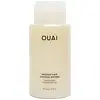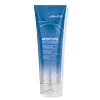What's inside
What's inside
 Key Ingredients
Key Ingredients

No key ingredients
 Benefits
Benefits

 Concerns
Concerns

 Ingredients Side-by-side
Ingredients Side-by-side

Water
Skin ConditioningSodium C14-16 Olefin Sulfonate
CleansingCocamidopropyl Betaine
CleansingSodium Methyl Cocoyl Taurate
CleansingCocamide Mipa
EmulsifyingGlycol Distearate
EmollientParfum
MaskingAmodimethicone
Hydroxypropyl Guar Hydroxypropyltrimonium Chloride
Glycerin
HumectantCitrus Japonica Fruit Extract
Skin ConditioningPanthenol
Skin ConditioningHydrolyzed Keratin
HumectantPolyquaternium-7
Orbignya Oleifera Seed Oil
EmollientCocos Nucifera Oil
MaskingPEG-150 Distearate
EmulsifyingSodium Lauroyl Glycinate
CleansingCetrimonium Chloride
AntimicrobialC11-15 Pareth-7
EmulsifyingLaureth-9
EmulsifyingTrideceth-12
EmulsifyingCocoglucosides Hydroxypropyltrimonium Chloride
CleansingAcrylates Copolymer
Tocopherol
AntioxidantPEG-200 Hydrogenated Glyceryl Palmate
CleansingPEG-7 Glyceryl Cocoate
EmulsifyingDisodium EDTA
Citric Acid
BufferingSodium Chloride
MaskingSodium Hydroxide
BufferingTetrasodium EDTA
Phenoxyethanol
PreservativeSodium Benzoate
MaskingPotassium Sorbate
PreservativeBenzyl Alcohol
PerfumingBenzyl Salicylate
PerfumingLimonene
PerfumingHexyl Cinnamal
PerfumingCI 15985
Cosmetic ColorantWater, Sodium C14-16 Olefin Sulfonate, Cocamidopropyl Betaine, Sodium Methyl Cocoyl Taurate, Cocamide Mipa, Glycol Distearate, Parfum, Amodimethicone, Hydroxypropyl Guar Hydroxypropyltrimonium Chloride, Glycerin, Citrus Japonica Fruit Extract, Panthenol, Hydrolyzed Keratin, Polyquaternium-7, Orbignya Oleifera Seed Oil, Cocos Nucifera Oil, PEG-150 Distearate, Sodium Lauroyl Glycinate, Cetrimonium Chloride, C11-15 Pareth-7, Laureth-9, Trideceth-12, Cocoglucosides Hydroxypropyltrimonium Chloride, Acrylates Copolymer, Tocopherol, PEG-200 Hydrogenated Glyceryl Palmate, PEG-7 Glyceryl Cocoate, Disodium EDTA, Citric Acid, Sodium Chloride, Sodium Hydroxide, Tetrasodium EDTA, Phenoxyethanol, Sodium Benzoate, Potassium Sorbate, Benzyl Alcohol, Benzyl Salicylate, Limonene, Hexyl Cinnamal, CI 15985
Water
Skin ConditioningCetearyl Alcohol
EmollientDimethicone
EmollientSorbitol
HumectantPropylene Glycol
HumectantBehentrimonium Chloride
PreservativeStearyl Alcohol
EmollientPhenoxyethanol
PreservativeCocos Nucifera Oil
MaskingRosa Canina Fruit Oil
EmollientLaurdimonium Hydroxypropyl Hydrolyzed Keratin
Skin ConditioningSimmondsia Chinensis Seed Oil
EmollientChlorella Vulgaris Extract
Skin ConditioningSea Water
HumectantHydrolyzed Algin
Arginine Hcl
Skin ConditioningPhosphatidylcholine
EmulsifyingIsopropyl Palmitate
EmollientCetyl Esters
EmollientHydroxyethylcellulose
Emulsion StabilisingCetrimonium Chloride
AntimicrobialGuar Hydroxypropyltrimonium Chloride
Skin ConditioningPolyquaternium-37
Aminopropyl Dimethicone
Tetrasodium Glutamate Diacetate
Propylene Glycol Dicaprylate/Dicaprate
EmollientPEG-4 Laurate
EmulsifyingCitric Acid
BufferingPEG-90m
Emulsion StabilisingPPG-1 Trideceth-6
Skin ConditioningIodopropynyl Butylcarbamate
PreservativeSodium Hydroxide
BufferingIsopropyl Alcohol
SolventLimonene
PerfumingBenzyl Benzoate
AntimicrobialParfum
MaskingCI 60730
Cosmetic ColorantCI 42090
Cosmetic ColorantCI 19140
Cosmetic ColorantWater, Cetearyl Alcohol, Dimethicone, Sorbitol, Propylene Glycol, Behentrimonium Chloride, Stearyl Alcohol, Phenoxyethanol, Cocos Nucifera Oil, Rosa Canina Fruit Oil, Laurdimonium Hydroxypropyl Hydrolyzed Keratin, Simmondsia Chinensis Seed Oil, Chlorella Vulgaris Extract, Sea Water, Hydrolyzed Algin, Arginine Hcl, Phosphatidylcholine, Isopropyl Palmitate, Cetyl Esters, Hydroxyethylcellulose, Cetrimonium Chloride, Guar Hydroxypropyltrimonium Chloride, Polyquaternium-37, Aminopropyl Dimethicone, Tetrasodium Glutamate Diacetate, Propylene Glycol Dicaprylate/Dicaprate, PEG-4 Laurate, Citric Acid, PEG-90m, PPG-1 Trideceth-6, Iodopropynyl Butylcarbamate, Sodium Hydroxide, Isopropyl Alcohol, Limonene, Benzyl Benzoate, Parfum, CI 60730, CI 42090, CI 19140
 Reviews
Reviews

Ingredients Explained
These ingredients are found in both products.
Ingredients higher up in an ingredient list are typically present in a larger amount.
This ingredient is a preservative, antimicrobial, and emulsifier. It is often used in cosmetics for its ability to cleanse, condition, and reduce static.
Cetrimonium chloride is a quaternary ammonium salt, meaning it has a water-soluble structure.
Citric Acid is an alpha hydroxy acid (AHA) naturally found in citrus fruits like oranges, lemons, and limes.
Like other AHAs, citric acid can exfoliate skin by breaking down the bonds that hold dead skin cells together. This helps reveal smoother and brighter skin underneath.
However, this exfoliating effect only happens at high concentrations (20%) which can be hard to find in cosmetic products.
Due to this, citric acid is usually included in small amounts as a pH adjuster. This helps keep products slightly more acidic and compatible with skin's natural pH.
In skincare formulas, citric acid can:
While it can provide some skin benefits, research shows lactic acid and glycolic acid are generally more effective and less irritating exfoliants.
Most citric acid used in skincare today is made by fermenting sugars (usually from molasses). This synthetic version is identical to the natural citrus form but easier to stabilize and use in formulations.
Read more about some other popular AHA's here:
Learn more about Citric AcidCocos Nucifera Oil is obtained from the kernels of the coconut fruit. In other words, this is coconut oil.
Coconut Oil is rich in fatty acids with lauric acid making up the majority of these. It also contains linoleic acid. Due to this high fatty acid content, coconut oil helps trap moisture and soften skin.
Despite being antibacterial, coconut oil may not be great for acne-prone skin. It is comedogenic and may clog pores. This ingredient may not be safe for malassezia or fungal acne.
Note: Coconut Oil should not replace your sunscreen for UV protection. Studies show it only blocks about 20% of UV.
This oil is non-volatile and has a light scent.
The term 'fragrance' is not regulated in many countries. In many cases, it is up to the brand to define this term. For instance, many brands choose to label themselves as "fragrance-free" because they are not using synthetic fragrances. However, their products may still contain ingredients such as essential oils that are considered a fragrance.
Learn more about Cocos Nucifera OilLimonene is a fragrance that adds scent and taste to a formulation.
It's found in the peel oil of citrus fruits and other plants such as lavender and eucalyptus. The scent of limonene is generally described as "sweet citrus".
Limonene acts as an antioxidant, meaning it helps neutralize free radicals.
When exposed to air, oxidized limonene may sensitize the skin. Because of this, limonene is often avoided by people with sensitive skin.
The term 'fragrance' is not regulated in many countries. In many cases, it is up to the brand to define this term. For instance, many brands choose to label themselves as "fragrance-free" because they are not using synthetic fragrances. However, their products may still contain ingredients such as essential oils that are considered a fragrance.
Learn more about LimoneneParfum is a catch-all term for an ingredient or more that is used to give a scent to products.
Also called "fragrance", this ingredient can be a blend of hundreds of chemicals or plant oils. This means every product with "fragrance" or "parfum" in the ingredients list is a different mixture.
For instance, Habanolide is a proprietary trade name for a specific aroma chemical. When used as a fragrance ingredient in cosmetics, most aroma chemicals fall under the broad labeling category of “FRAGRANCE” or “PARFUM” according to EU and US regulations.
The term 'parfum' or 'fragrance' is not regulated in many countries. In many cases, it is up to the brand to define this term.
For instance, many brands choose to label themselves as "fragrance-free" because they are not using synthetic fragrances. However, their products may still contain ingredients such as essential oils that are considered a fragrance by INCI standards.
One example is Calendula flower extract. Calendula is an essential oil that still imparts a scent or 'fragrance'.
Depending on the blend, the ingredients in the mixture can cause allergies and sensitivities on the skin. Some ingredients that are known EU allergens include linalool and citronellol.
Parfum can also be used to mask or cover an unpleasant scent.
The bottom line is: not all fragrances/parfum/ingredients are created equally. If you are worried about fragrances, we recommend taking a closer look at an ingredient. And of course, we always recommend speaking with a professional.
Learn more about ParfumPhenoxyethanol is a preservative that has germicide, antimicrobial, and aromatic properties. Studies show that phenoxyethanol can prevent microbial growth. By itself, it has a scent that is similar to that of a rose.
It's often used in formulations along with Caprylyl Glycol to preserve the shelf life of products.
Sodium Hydroxide is also known as lye or caustic soda. It is used to adjust the pH of products; many ingredients require a specific pH to be effective.
In small amounts, sodium hydroxide is considered safe to use. However, large amounts may cause chemical burns due to its high alkaline.
Your skin has a natural pH and acid mantle. This acid mantle helps prevent harmful bacteria from breaking through. The acid mantle also helps keep your skin hydrated.
"Alkaline" refers to a high pH level. A low pH level would be considered acidic.
Learn more about Sodium HydroxideWater. It's the most common cosmetic ingredient of all. You'll usually see it at the top of ingredient lists, meaning that it makes up the largest part of the product.
So why is it so popular? Water most often acts as a solvent - this means that it helps dissolve other ingredients into the formulation.
You'll also recognize water as that liquid we all need to stay alive. If you see this, drink a glass of water. Stay hydrated!
Learn more about Water